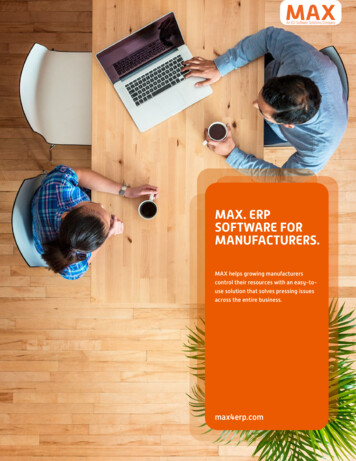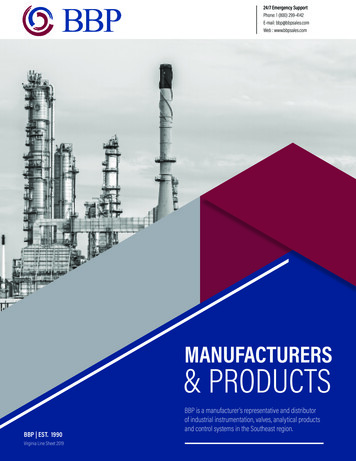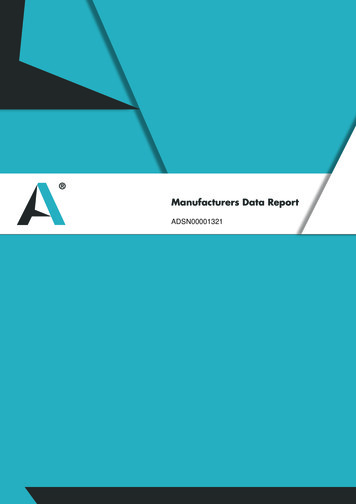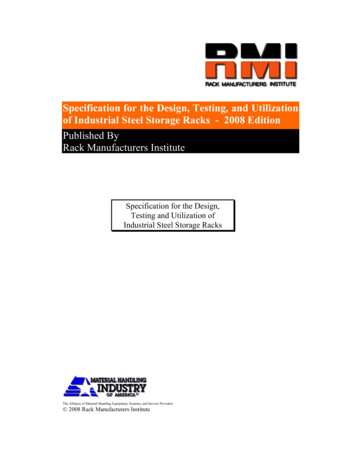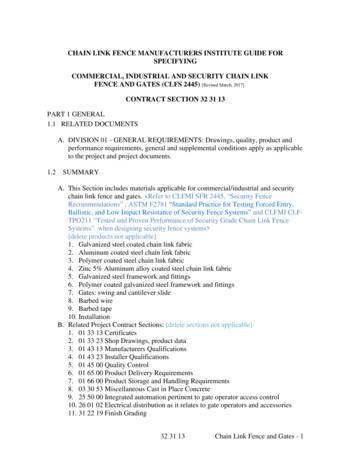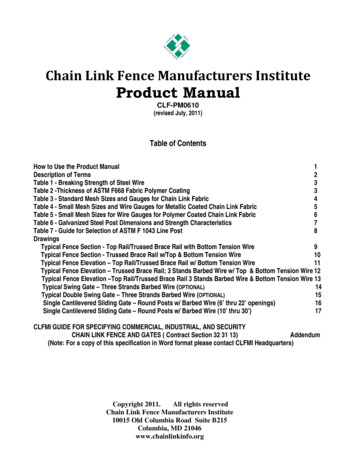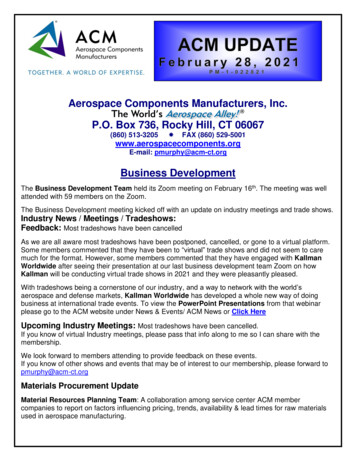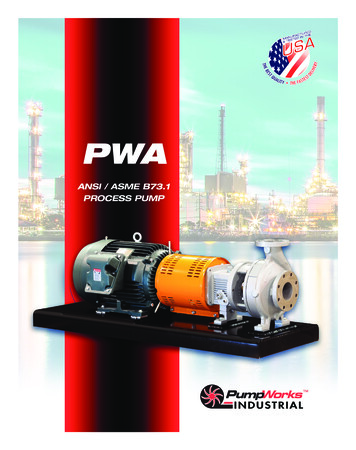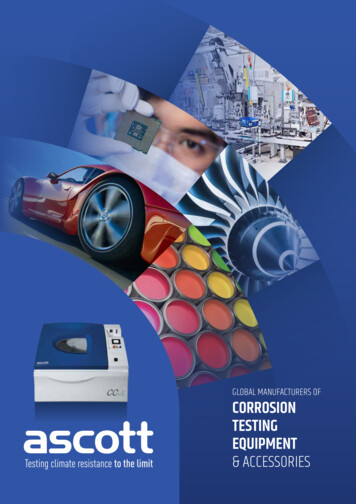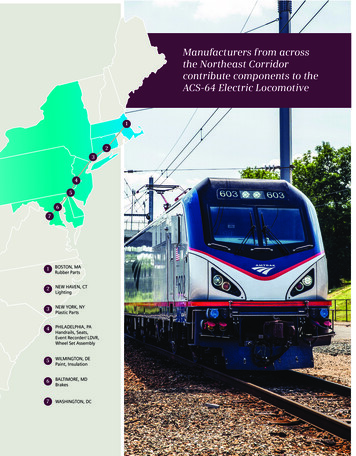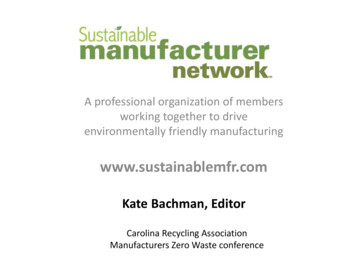
Transcription
A professional organization of membersworking together to driveenvironmentally friendly manufacturingwww.sustainablemfr.comKate Bachman, EditorCarolina Recycling AssociationManufacturers Zero Waste conference
I. Landfill Factoids
Landfill FactoidsSources: “Things You Might Not Wanna KnowAbout Trash and Landfills”) 2009 Planet Green.com, a Discovery co. CNBC “The Secret Life of Garbage” NPR U.S. Environmental Protection Agency website
Landfill Factoids1. Average human 1,500 pounds of garbage / year (4.5 lbs. / day) -1,200 pounds is organic waste2. No one produces more trash than the U.S. (2009)5% of the world's people generate40% of the world's waste3. In 2013, Americans generated about 254 million tons of trash. Werecycled and composted about 87 million tons of this material 34.3 % recycling rate. (US EPA; 2013)4. In NYC, 25,000 tons of municipal solid waste generated / day (2009)
Landfill Factoids5. Annually, America's landfills become home to 1,600,000,000 pens 2,000,000,000 razor blades 2,548,000,000 disposable diapers 220,000,000 car tires *6. The average baby uses 6,000 diapers 49 million disposable diapers / day in the U.S. 200 to 500 years to decompose7. Decomposition times vary widely.Banana peels 2-10 daysCotton: 1-5 monthsAluminum cans: 80-100 yearsGlass bottles: 1,000,000 years
Landfill Factoids8. Largest — America's largest landfill, Puente Hills Landfill, LA50 years in operation, the landfill grew higher than 500 feet. Closed in 2014.Highest, 6th largest landfill --Mount Rumpke," Rumpke sanitary landfill in HamiltonCounty, Ohio towers 1,075 ft. above sea level; 230 acres9. Landfills release gases, primarily carbon dioxide, methane, and carbonmonoxide. However, "landfill gas" is a potential source of alternative energy;natural gas for electricity, heat in managed landfills.10. The U.S. has a LOT of landfills! 1,794 landfills (Planet Green; Discovery, 2009) 3,091 active landfills and over 10,000 old municipal landfills, according to ZeroWaste America, citing the Environmental Protection Agency
II. Why are landfills a focus ofmanufacturers’ efforts?
Why focus on landfills?Landfill Trends1. They are filling up2. Some are closing3. Some states have placed a moratoriumon new landfills4. Increased disposal, transportation costs
Why focus on landfills?5. Geographic stigma: “We don’t want another state dumpingits garbage in ours” “We’ve become the pay toilet of the nation”6. Toxic waste into water table?7. Gas leachate GHG emissions
Why focus on landfills?8. Wasted resources“Waste is just poor design”9. Managing waste well eco-responsible10. Humankind is affecting theenvironment--cumulative effect
III. What can manufacturers do?
What can manufacturers do?What are manufacturers doing?
So, what can manufacturers do?Go For Zero!zero landfill, zero waste
Manufacturers going zeroYou’re free
Manufacturers going zeroYou’re in good companyMore than half of FORTUNE 500 companieshave waste reduction goals37 of FORTUNE 500 have zero waste-tolandfill goals
Manufacturers going zeroYou’re in good companyManufacturers that have achieved zero landfill,virtually zero landfill, or have zero landfill goalsABBAbus hardware/ABUS Hardware (Shenzhen)AvivaBridgestone Americas Wilson NCBurt’s BeesCrown Lift TrucksDaimlerFreightliner Custom Chassis Corp.GAF Material/TPO PlantGAF Material/EverguardTPO Plant
Manufacturers that have achieved zero landfill,virtually zero landfill, or have zero landfill goalsGeneral MotorsGlaxoSmithKlineHaworthHondaHyperthermKroger manufacturing plantsLandfill FormsMayer Brothers / West Seneca NY plantNational Office Furniture, a division of Kimball InternationalNestleNorthrup Grumman
Manufacturers that have achieved zero landfill,virtually zero landfill, or have zero landfill goalsPurdy Professional Paint ProductsRB, London, zero waste to landfill in Europe, North AmericaSchick, Milford, CTShiloh IndustriesStarbucks Coffee; York Roasting PlantPanasonicSubaruSunPower , Mexicali, MexicoToyotaUnilever
IV. Go For Zero! How?zero landfill, zero waste ReduceReuseRecycleCompostRecover energyfrom-waste
Go For Zero! How?1. Source reductionEngineer to reduce waste generated
Go For Zero! How?2. ReuseFCCC uses reusable, returnablemetal rackingHonda of South Carolina Mfg.returnable, reusable metal crates
Go For Zero! How?3. RecycleSegregate waste for collection FCCCIn-plant sorting systemPurdy Professional Products,Sherwin-Williams
Go For Zero! How?4. Compost
Go For Zero! How?5. Recover energy from waste Combustion Biogas (food, farm animals) Landfill Gas Capture Aerobic Digesters
Go For Zero! How?6. Cultivate zero waste culture(Cradle-to-cradle,Circular Economy)Bridgestone’s Tires4Ward
Go For Zero! How?7. Use recycled content(create demand)Ford’s Repreve upholstery fabric , madefrom 100 percent recycled materials
Go For Zero! How?8. Manufacture using recyclable materialsFrito Lay Recyclable Seasoning BagsDell’s packaging-recycled content- recyclable
Go For Zero! How?Get yourmaterialscategorized asrecyclable(Dordan Mfg.)
Go For Zero! How?9. Design fordeconstruction ordisassembly, reuse atend of life (Steelcase)
Go For Zero! How?10. Set up takeback programs(Producer Responsibility)Tile manufacturer Crossville, Crossville, Tenn.,diverted 24 million lbs. of porcelain from landfillssince launching its Tile Take-Back program
Go For Zero! How?Manufacturers with Take Back programsAnheuser-Busch – Reusable packagingApple –ComputersBosch – Power ToolsBridgestone – TiresDell – computersEpson – Recycle Used Computer Hardware ProductsElectronics & Computers Dell – ComputersFord – Bumper Take-Back ProjectHewlett Packard – ElectronicsIBM – Computers, Battery Packs, & Other SuppliesKodak – Recyclable CamerasLexmark – Recycling Program for Ink Cartridges, HardwareMotorola – Mobile PhonesNokia – Mobile phonesToshiba –laptops & MP3 ndfill/Take%20Back%20Programs.pdf
Go For Zero! How?11. Communicate tocommunity,networks,industry partners,suppliersand customers
Go For Zero! How?Communicate to suppliers“We don’t want our suppliers giving us a black eye”Roger Nielsen, Daimler Trucks NA
Go For Zero! How?12. Give and receive support
V. What is Zero Waste?
What is zero waste? Virtually zero waste to landfill Zero waste to landfill (plant)(EfW) Zero waste to landfill (entire facility)(EfW) Zero waste to landfill (entire facility, none to EfW) Zero emissions from waste Zero waste (none generated)
What is zero waste?Virtually zero waste to landfill95% waste diverted from landfill(Frito Lay, Beloit, WI)
What is zero waste?Zero waste to landfill (factory)(Subaru—first to zwl in 2004)
What is zero waste?Zero waste to landfill (entire facility)with 20% EfW facilityCrown Equipment
What is zero waste?Zero waste tolandfill (entirefacility)“Zero means zero”No waste to energy-fromwaste facilityPurdy Professional PaintingProducts (Sherwin Williams)
What is zero waste?Zero waste (none generated)Burt’s Bees; (goal)
VI. How Prove?How set definitive target?How define, measure, quantify your zero goal?How relay to employees, create team approach?How establish reporting structure, process, protocol?How provide verifiable results to customers?
How Prove?Third-party Certifications
How Prove? Third-party Certifications4 Certifying Organizations UL EnvironmentUS Zero Waste Business CouncilGreen Circle CertifiedNSF-ISRSource: Jeff Gowdy, of J. Gowdy Consulting
How Prove? Third-party Certifications Documentation Plant audit Maintenance plan, recertification
How Prove? Third-party CertificationsUL EnvironmentZero Waste toLandfill (100%)ReuseRecycleVirtually Zero Wasteto Landfill ( 98%)CompostLandfill WasteDiversion( 80%)Energy–from–waste(combustion and anaerobic)
How Prove? Third-party CertificationsUL Environment
How Prove? Third-party CertificationsUS Zero Waste Business Council90% �waste(anaerobic)Energy–from–waste(combustion) not count aspart of 90% diversion
How Prove? Third-party CertificationsUS Zero Waste Business Council
How Prove? Third-party CertificationsNSF-ISRLess Than 1%Diversion RateReuseRecycleCompost Demonstrate that lessthan 1 percent ofprocess waste is beingsent to �waste(combustion)
How Prove? Third-party CertificationsNSF-ISRIn Tremonton, Utahprocessing facility
How Prove? Third-party CertificationsGreen Circle CertifiedReuseNo Specific ThresholdRecycleCompostPerforming a material flow and massflow analysis, GreenCircle quantifiesand certifies a percentage of wastediverted from landfillsIn other words, there are no specificthresholds, but will certify to theexact �from–waste(combustion)
How Prove? Third-party CertificationsGreen Circle Certified*Note that no percentage levels are specified for these examples
VII. Why?The Whys from the Eco-wise
Why?Brand Strategy“Our belief in creating truly natural productsthat are good for you, the environment,“We have found that wecan do wellby doing good.”—Environmental Sustainability Manager SteveWalker, Burt’sBees
Why?Industry Leadershipbeing anindustry leader in every aspectof our business, Bridgestone Americas strives toAs part of our commitment tobe a good steward of the earth and its resources.Bridgestone has a long-standing commitment to sustainabilitythat is reflected in our company’s environmental mission “tohelp ensure a healthy environment for current and futuregenerations.”--Bridgestone
Why?Competitive Advantagecompetitiveadvantage within the lifttruck industry to say that wefocus on sustainablemanufacturing and have an environmental“It provides us with amanagement system. It becomes engrained in everything thatyou do. It becomes second nature.”-Crown Equipment
Meet Consumer Demandappetite from consumers to haveproducts that are more eco-friendly.There’s an increasing“You remove waste and eliminate that cost—maybe even make it an incomestream—and it goesstraight to the bottom line.”Our guiding values are integrity, service, quality, people, performance,innovation, growth.It’s the right thing to do.—Brenda Demaree, PurdyWilliamsProfessional Paint, Sherwin-
Why?Waste Costs“At one time that people would say, ‘Oh it costs too much tobe environmentally friendly. We can’t do that.’ I think now,it really coststoo much money to not beenvironmentally friendly--thatwaste is money. That whenever you’repeople are finally realizing thatthrowing something out, you’re spending money. You’repaying for it at the front end. You’re paying for its disposal.--Denise Coogan,Subaru
Good MaterialsManagementManaging waste well is partof the company’s sustainability vision statementthat includes sustainable product and workspaceIt’s just goodbusiness sense.”design. ““Our founder, G.W. Haworth, would call me up and‘Why are we throwingthis away?’ And so our background was tosay, ‘understand what our waste streams were and to tryto reduce those.—Bill Gurn,Haworth
Sustainability ProgramSchick sought to improve its waste recyclingan extension ofour sustainabilityprogram and ongoingcontinuousimprovement initiatives of therate ascompany’s ISO 14001 program, -ScottSutkowski,Schick/Energizer
Change Company Culture“The biggest part of our success, I feel, is how our employeeshave taken ownership of the program—how they have becomewhole evolution ofenvironmental responsibility.empowered—theEmployees here go home, make those changes there, affect theirspouses, their family members who work at all these otherplaces, their children in their schools, the community--BillHarris, Freightliner Custom Chassis.“People who used to throw things out of the window of theircars now are looking to reduce the waste we generate.”—Ryan Pennington, FreightlinerCustom Chassis
Overall Environmental Effects“We all look for ways that we can improve the environment.It’s something that’s a given now.It changedthe culture. As a result, we’ve seen a hugereduction in all of ourenvironmental metrics.”—Rhonda Scherer,National Office Furniture
“Eco-responsible”
Eco-responsible
8. Largest —America's largest landfill, Puente Hills Landfill, LA 50 years in operation, the landfill grew higher than 500 feet. Closed in 2014. Highest, 6th largest landfill --Mount Rumpke," Rumpke sanitary landfill in Hamilton County, Ohio towers 1,075 ft. above sea level; 230 acres 9.

